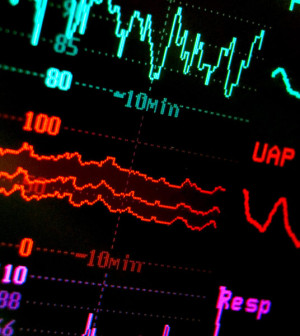- Navigating Your Midlife Crisis: Embracing New Possibilities
- City Raccoons Showing Signs of Domestication
- Mapping the Exposome: Science Broadens Focus to Environmental Disease Triggers
- One Week Less on Social Media Linked to Better Mental Health
- Your Brain Changes in Stages as You Age, Study Finds
- Some Suicide Victims Show No Typical Warning Signs, Study Finds
- ByHeart Formula Faces Lawsuits After Babies Sickened With Botulism
- Switch to Vegan Diet Could Cut Your Greenhouse Gas Emissions in Half
- Regular Bedtime Does Wonders for Blood Pressure
- Dining Alone Could Mean Worse Nutrition for Seniors
Statewide Training on Cardiac Arrest Saves Lives in N. Carolina

A North Carolina program to increase bystander action in cases of cardiac arrest saved lives and reduced brain damage among survivors, a new study shows.
The statewide program trained family members and the general public to recognize the signs of sudden cardiac arrest and to perform CPR and use automated external defibrillators (AEDs).
“You can do something,” said study author Dr. Christopher Fordyce, of the Duke Clinical Research Institute in Durham, N.C. “You don’t have to just call 911 and stand while your loved one is on the floor. Start chest compressions immediately. Your actions actually make a difference.”
Cardiac arrest is the sudden loss of heart function in someone with or without known heart disease, according to the American Heart Association.
The North Carolina study found that the rate of bystander CPR for cardiac arrests that occurred in public places rose from 61 percent in 2010 to more than 70 percent in 2014. And, the rate of bystander CPR for cardiac arrests that occurred in homes rose from just over 28 percent to just over 41 percent.
In-home defibrillator use by bystanders rose from about 42 percent to more than 50 percent. There was no increase in AED use in public places, likely due to timely defibrillator use by emergency medical service personnel, according to the study authors.
The study is to be presented April 3 at an American College of Cardiology meeting in Chicago.
Meanwhile, rates of patients who survived until they left the hospital rose from about 11 percent to nearly 17 percent for public cardiac arrests, and from less than 6 percent to 8 percent for in-home cardiac arrests.
Gains in brain function were reported as well. Rates of patients who had minor or no loss of brain function rose from almost 5 percent to slightly more than 6 percent for in-home cardiac arrests, and from 9.5 percent to close to 15 percent for public cardiac arrests, the researchers said.
“The absolute rates are small, but the relative changes were pretty large. That’s only over five years, so if we continue to educate the public, we can continue to improve outcomes,” Fordyce said in a cardiology meeting news release.
“What’s interesting about this study is it’s the first time a statewide intervention has improved both public and residential cardiac arrest outcomes,” he noted.
Each year, more than 420,000 out-of-hospital cardiac arrests occur in the United States, the researchers said.
Research presented at meetings is usually considered preliminary until published in a peer-reviewed medical journal.
More information
The American Heart Association has more about cardiac arrest.
Source: HealthDay
Copyright © 2025 HealthDay. All rights reserved.










